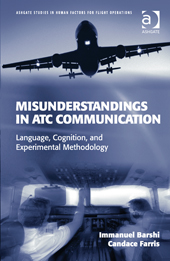Misunderstandings in ATC Communication
- Publisher
- Ashgate
- Price
- 55.00 UKP
- Authors
- Immanuel Barshi, Candace Farris
Summary
Language, Cognition, and Experimental Methodology
Effective radio communication between ATC and pilots has long been recognized as an important element of aviation safety. In recognition of the role miscommunications play in aviation incidents and accidents, the International Civil Aviation Organization (ICAO) recently introduced language proficiency requirements for all flight personnel in all ICAO member states. Using an effective and economical experimental paradigm, the research described here teases apart the complex combination of factors (e.g. speech rate, controller message length, English language proficiency, cognitive workload) believed to contribute to miscommunications between controllers and pilots.
-
Misunderstandings in ATC Communication offers an in-depth report of a seminal study in aviation communication, which until now has only been available in the form of an unpublished dissertation. In addition, it offers a recent extension of that work, the authors’ reflections on the research process, and a thorough review of the aviation communication literature. Graduate students and researchers who wish to address real-world problems will appreciate the simple elegance of the experimental paradigm that has been used to address a wide range of theoretical and applied interdisciplinary research questions.
The book will appeal to scholars in the fields of human factors, linguistics, cognitive psychology, applied linguistics and second-language education and assessment. It is also of direct relevance to government and industry decision-makers and operators as they strive to implement the ICAO requirements, and to improve aviation safety. -
Contents: Introduction; Part I The Effects of Linguistic Properties and Message Length on Misunderstandings in Aviation Communication: Introduction to part I; Air Traffic Control radio communication; The omission and deletion of linguistic elements in ATC clearances; Experimental study of ATC-like instructions; Conclusion to part I. Transition. Part II The Effects of Message Length, Second Language Proficiency and Cognitive Workload in Aviation Communication: Introduction to part II; Literature review; Methods; Results; Discussion; Implications and conclusions for part II; Final conclusion; Appendices; References; Index.
-
About the Author: Immanuel Barshi is a Senior Principal Investigator in the Human Systems Integration Division at NASA Ames Research Center. His current research addresses cognitive issues involved in the skilled performance of astronauts and pilots, as well as mission controllers and air traffic controllers, their ability to manage challenging situations, and their vulnerability to error. Among the topics investigated by his research group are spatial reasoning, decision making, risk assessment, communication, and skill acquisition and retention. The results of his work have been implemented in checklist design, operational procedures, and training programs in space, aviation, medicine, and nuclear facilities.
Dr. Barshi holds PhDs in Linguistics and in Cognitive Psychology. He has published books and papers in basic and applied psychology, linguistics, and aviation. He holds Airline Transport Pilot certificate with A320, A330, B737, and CE500 Type Ratings; he is also a certified flight instructor for airplanes and helicopters, with over 35 years of flight experience.
Candace Farris is a doctoral student at McGill University in Montreal, Canada. Her current research addresses interaction between controllers and pilots in radio communication, with the objective of identifying skills required for successful communication in the global aviation context. Her findings are applicable to the field of aviation communications training and assessment for native and non-native speakers alike. Candace has over 10 years experience in aviation, having worked in the airline industry and as a consultant for the International Civil Aviation Organization. -
Reviews: ‘Kudos to the authors for successfully marrying the results of hard-core, academic studies conducted in the laboratory with analyses of data from real ATC transcripts, to produce tangible recommendations that can be directly put into practice in the field. An insightful book that will appeal to academics and practitioners alike, and is sure to make a difference in improving the effectiveness of pilot-controller communication.’
Loukia Loukopoulos, errorManagement, Europe
‘This multi-method book is informative as well as easy and fun to read. The authors include an excellent mix of using real world data and laboratory research to understand ATC-pilot communication. Students in many different areas of research can learn from this example of converging methods. Those involved in the field, especially those with power to make changes in prescribed routines, should read this book.’
Vivian Schneider, University of Colorado at Boulder, USA





.jpg)

.png)

